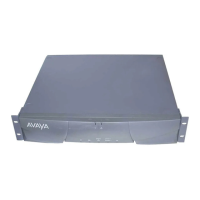PKT-BUS (Packet Bus)
Issue 1 May 2002
8-1231555-233-143
This section on the PKT-BUS MO is limited to a description of the Error and Alarm
Log entries and the test sequence for the packet bus. The following list
summarizes some of the important points to consider when working with the
packet bus.
■ The Maintenance/Test circuit pack (TN771D) is a critical tool for isolating
packet bus faults. This circuit pack resides in each port network of a
critical-reliability system (duplicated Avaya MultiVantage™ software and
PNC). In a duplex-, or high-reliability system, the circuit pack may be
included as a customer option. If a TN771D is absent, one must be taken
to the customer site to allow for proper fault isolation. The ‘‘Isolating and
Repairing Packet-Bus Faults’’ section in Chapter 4, ‘‘Alarms, Errors, and
Troubleshooting’’ describes the Packet Bus testing facilities of the TN771D
and when one must be taken to the customer site.
■ Certain catastrophic packet-bus faults have an effect on maintenance
software activities relating to packet circuit packs, ports, and endpoints:
— Packet circuit pack (BRI-BD, UDS1-BD) in-line errors indicating
possible Packet Bus test failures are logged in the error log, but are
not acted upon.
— Port-level (BRI-PORT, ABRI-PORT) in-line errors on Packet circuit
packs which indicate possible Packet Bus failures are not logged or
acted upon.
— Circuit pack and port in-line errors that are not relevant to the Packet
Bus, or that indicate a circuit pack failure, are acted upon in the
normal fashion.
— Periodic and scheduled background maintenance are not affected.
— Foreground maintenance (for example, a test board command
executed at a terminal) is not affected.
The actions in the previous list serve to reduce the system load, which
could become excessive if many MOs are affected by a packet bus failure.
However, such an excessive load should in no way impede the isolation
and the correction of the faults.
When the above actions are implemented, Error Type 3329 is logged
against PKT-BUS, and a Warning alarm is raised. Other Packet Bus errors
may raise more severe alarms, thereby overriding the Warning alarm.
■ Since all packet traffic requires communication with the IPSI’s PKT-INT
circuit in an IPSI-connected PN, a PKT-BUS failure in the IPSI-connected
PN causes packet traffic in this PN, and every PN controlled by the
IPSI-connected PN, to fail. In the S8700 Multi-Connect configuration where
some PNs are non-IPSI-connected, an IPSI-connected PN PKT-BUS fault
should be investigated first whenever PKT-BUS problems occur in multiple
PNs.

